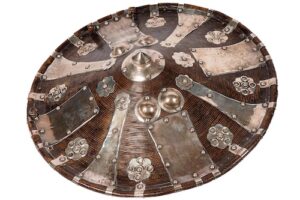
Ethiopian shield withdrawn from auction, looted in 1868, withdrawn from auction. Courtesy Anderson & Garland, 2024.
A protest by the Ethiopian Heritage Authority has led to the withdrawal of an ornamented shield from an auction in northern England. A February 2024 sale at a local auction house in Newcastle upon Tyne estimated that the embossed metal and hide shield, would sell for £800-£1,200. Its center boss had been engraved with the words “Magdala 13th April 1868.” The auction house had identified the shield as taken during the destruction of the Ethiopian Emperor Tewodros’s army and the burning of the mountain fortress of Magdala or Maqdala in 1868. The request to withdraw the shield was made by Abebaw Ayalew, director general of the Ethiopian Heritage Authority, who thanked the auction house for its prompt action to remove it.
The shield, along with many other objects of historical and religious importance, had been seized as booty in the 1868 British attack on Ethiopian Emperor Tewodros. Tewodros was holding a number of British missionaries and a diplomat hostage after a perceived slight by Queen Victoria at Maqdala. In 1867 a large British expeditionary force led by Sir Robert Napier was sent to rescue the captives.

The plateau at Arogye, overlooking the route to Maqdala, photo Richard Harvey, 4 October 2007, CCA-SA 3.0 Unported license.
Napier’s expeditionary force encountered numerous hardships on its journey into the interior but by April 1868 the troops and their artillery had climbed into the mountains of Ethiopia. After their first attack, Tewodros returned the European hostages, but killed the Indian captives, cutting off their hands and feet before throwing them off a cliff. A courageous rush on the British defenses by spear-wielding Ethiopians was repulsed by British and Indian troops armed with Snider-Enfield rifles. This skirmish left 500 Ethiopians dead in less than two hours and the British forces pressed onward to enter the fortress. The Emperor Tewodros committed suicide rather than be taken prisoner, using a pistol he had been given by Queen Victoria. When his troops surrendered, the British sacked Maqdala, including its churches, and burned the town.
Tewodros’ son taken to Britain
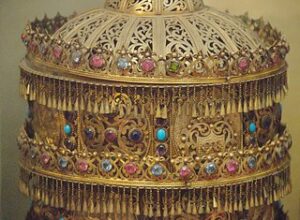
Ethiopian Crown, collection of the National Museum, Addis Ababa, Ethiopia, 22 October 2007. Photo A. Davey, CCA 2.0 Generic license.
Tewodros’ widow, Empress Tiruwork Wube, told Napier that Tewodros had asked the British to care for his young son if he was killed. Tewodros’ son, Prince Dejatch Alamayehu, age seven, was brought back to England and raised under the guardianship of Captain Tristram Speedy, a member of the British Expedition. Prince Alamayehu was photographed in 1868 with a ceremonial shield behind him by Julia Margaret Cameron, who like his guardian, Captain Tristram Speedy, had a home on the Isle of Wight. The young Prince Alamayehu was educated at Cheltenham College, Rugby School and the Royal Military Academy Sandhurst. He suffered from loneliness and depression and died at age 18. He was buried at St. George’s Chapel at Windsor Castle. (The Ethiopian government has long sought the return of his remains, which Queen Elizabeth declined to disturb.)
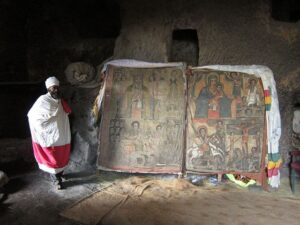
Monk and painting inside Rock-hewn church in Lalibela, Ethiopia. Photo Martijn Munneke, 3 February 2012, CCA 2.0 Generic license.
This is the second time that auctions of items taken from Maqdala have been halted at the last minute. In 2021, the auction of a group of three horn beakers and a leather Coptic Bible was removed from auction after protests by Ethiopian cultural authorities. British writer Tahir Shah later arranged for his nonprofit Scheherazade Foundation to purchase the items for a few hundred pounds in order to return them to Ethiopia.
After this first auction was cancelled, a Brussels collector sold the Scheherazade Foundation other objects taken from Maqdala, a cross, a priestly crown, an imperial shield and a talismanic scroll. All were returned to Ethiopian representatives to be given to the National Museum in Addis Ababa or offered to the Ethiopian Orthodox Church. These objects, like the shield withdrawn from auction in February, are of low value in the marketplace, being valued altogether at a few thousand pounds, but have particular meaning to the Ethiopian people.
British collections of Ethiopian artifacts
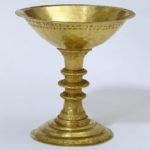
Chalice made by Walda Giyorgis in Gondar, Ethiopia, 1735-40. Museum no. M.26-2005. © Victoria and Albert Museum, London.
Westminster Abbey is also in possession of a religious artifact from Ethiopia, which it agreed in February 2024 to return “in principle.” The wood and stone object is a tabot or sacred tablet symbolic of the Ark of the Covenant. Tabot are reverenced as the most sacred objects and are of great religious importance in Ethiopia. They are not considered suitable for public viewing; they are held to be symbolic renderings of the Ark of the Covenant and tablets of Moses on which the Ten Commandments were inscribed. A tabot is held in the sanctuary or holy of holies in Ethiopian Orthodox Churches, accessible only to priests, and tabots are worn as part of the ceremonial headgear of Orthodox priests.
A tabot has been held by Westminster Abbey since 1870. At that time, it was inserted within a newly built altar in the Henry VII Lady Chapel, together with fragments from the high altar of Canterbury Cathedral and from a major Greek Orthodox church altar. In 2007, after the head of the Ethiopian Church visited Westminster to ask for its return, a covering was placed over the part of the tabot that was visible at the altar, so that no part of it can be seen. King Charles would have to authorize return of the tabot in Westminster Abbey in his capacity as the supreme governor of the Church of England. Recently, the return of the tabot at Westminster has again gained notoriety, as Ethiopian priests requested and were denied the right to perform a ceremony and pray in chapel before it.
The British Museum possesses eleven tabots and treats them in the manner requested by the Ethiopian Orthodox Church. The tabots in the British Museum have never been on display, or been studied, copied or photographed. They are housed in a location specially set aside for the purpose, created and maintained in close consultation with the Ethiopian Church.
Negotiations for return of artifacts
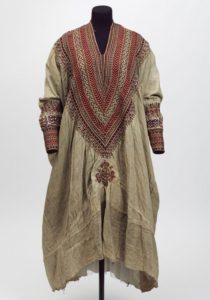
Dress, around 1860, Ethiopia. Museum no. 399-1869. © Victoria and Albert Museum, London.
During 2018, several British institutions chose to exhibit Ethiopian art and artifacts to mark the 150th anniversary of the Battle of Maqdala. Exhibitions at the British Museum, British Library, and Victoria and Albert Museum used the objects to illuminate the history of the Ethiopian conflict. The museums hoped that bringing forward the truth about the 1868 British punitive expedition would involve the public in a serious discussion about the objects and their history. As it happened, the institutions got more discussion than they were looking for.
After the Victoria and Albert Museum’s special exhibition in 2018, ‘Maqdala 1868’ the museum offered to place their objects on a long-term loan to Ethiopia. When the exhibition opened, Director Tristram Hunt expressed the V&A’s intention that the works would go back to Ethiopia on long term loans. Ethiopia’s ambassador, Hailemichael Afework Aberra, had positive words for the prospective loan agreement. Later, however, Ambassador Aberra told The Art Newspaper that “My government is not interested in loans, it is interested in having those objects returned.”
Ethiopian objects were collected in England prior to the Maqdala expedition and not all are looted. Other objects in the various museum shows had a more mixed history. The 2018 British Library exhibition, African Scribes: Manuscript Culture of Ethiopia, included several of the 349 manuscripts taken from Maqdala as loot, but others had been acquired in 1753. Seventy four Ethiopian codices were collected by the missionaries Carl Wilhelm Isenberg and Johann Ludwig Krapf in the 1830s and 1840s during their travels to the little known kingdom of Shewa or Shoa.[1]. The British Library also has 110 illuminated Ethiopian manuscripts containing over 3000 painted miniatures.
Ethiopian laws and international conventions
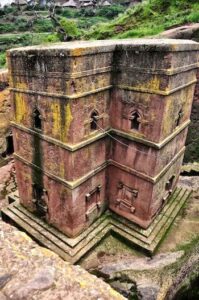
Rock-hewn Church Lalbela, Ethiopia, Cut from bedrock then hollowed out inside. Photo Rod Waddington, 27 September 2011, CCA-SA 2.0 Generic license.
Ethiopia has a domestic law, the 2000 Proclamation to Provide for Research and Conservation of Cultural Heritage with characteristic provisions defining movable, immovable and intangible heritage and requiring government permission for excavation and construction. The Ethiopian law also permits the government to expropriate any cultural heritage from individuals or institutions that is not properly protected or restored, or which the government determines should be in a museum, or which has been seized when it was being taken out of the country without permission.[2]
Ethiopia signed World Heritage Convention in 1977. The country has eleven sites on the World Heritage List, nine of them are cultural heritage sites and are natural heritage sites.[3] Recently, UNESCO has expressed serious concern for the preservation of one of its most famous complex of sites in Lalibela, Ethiopia, the 11 thirteenth century cave churches that are known as the Rock Hewn Churches. UNESCO has noted that there is severe degradation of the monuments from water damage and they are now in a critical condition. However, while tentative plans for preservation have been made at various times, they have not ever been organized, much less fulfilled.
Ethiopia has not engaged other countries that hold Ethiopian objects under international instruments in the past. Ethiopia ratified the 1970 UNESCO Convention through a proclamation in October 2003, but the country has apparently not deposited the instruments of ratification with UNESCO so it is not listed among the States Parties.[4]
NOTES
[1] Isenberg tangled with the Ethiopian Orthodox Church and was in part responsible for the subsequent expulsion of the entire Mission from Ethiopia. Isenberg and Kraft were both linguists, and Isenberg compiled a dictionary and comprehensive grammar of the Amharic language and translated the Scriptures into several African languages.
[2] Folarin Shyllon, Legislative and Administrative Implementation of 1970 UNESCO Convention by African States: The Failure to Grasp the Nettle, International Journal of Cultural Property , Volume 21 , Issue 1 , February 2014 , pp. 23 – 53, DOI: https://doi.org/10.1017/S0940739113000301.
[3] These sites are Aksum (1980), Fasil Ghebbi, Gondar Region (1979), Harar Jugol, the Fortified Historic Town (2006), Konso Cultural Landscape (2011), Lower Valley of the Awash (1980), Lower Valley of the Omo (1980), Rock-Hewn Churches, Lalibela (1978), The Gedeo Cultural Landscape (2023), Tiya (1980), Bale Mountains National Park, Simien National Park (1978).
[4] https://www.unesco.org/en/legal-affairs/convention-means-prohibiting-and-preventing-illicit-import-export-and-transfer-ownership-cultural#item-2
 Déjatch Alámayou, photographed July 1868, by Julia Margaret Cameron. Scanned from Colin Ford's Julia Margaret Cameron: 19th Century Photographer of Genius. Originally from Collection of JGS, Inc., New York.
Déjatch Alámayou, photographed July 1868, by Julia Margaret Cameron. Scanned from Colin Ford's Julia Margaret Cameron: 19th Century Photographer of Genius. Originally from Collection of JGS, Inc., New York. 

